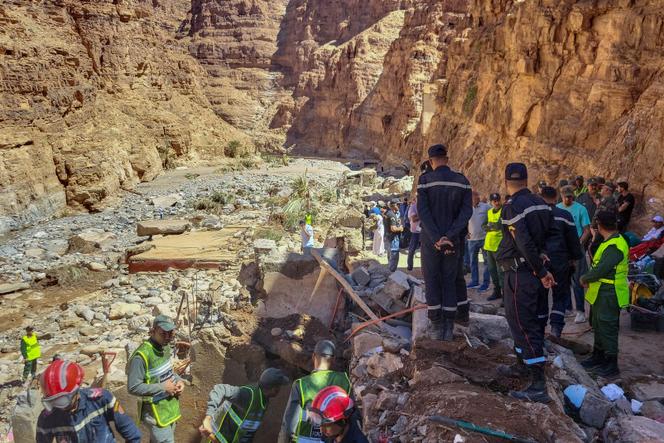


A rare and deadly phenomenon: According to the latest count, published by the Moroccan interior ministry on the evening of Monday, September 9, 18 people have died as a result of the torrential rains that fell on Friday and Saturday in several regions of the kingdom. Among the victims were a Spaniard, a Canadian and a Peruvian. The death toll was particularly high in the province of Tata, southeast of Agadir, where 10 deaths were recorded in the flooded villages of Igmir and Aoukerda alone, in the immediate vicinity of the Tamanart wadi.
Perched at an altitude of 1,000 meters in the Anti-Atlas mountains, the two villages, trapped in the steep gorges of Smouguen, were ravaged by an avalanche of muddy water that caused several buildings to collapse. Rescue operations began on Sunday with the arrival of the army but residents are still reportedly under the rubble. At least four people are still missing.
The extraordinarily violent flood swept bodies away along the river over a distance of more than 30 kilometers, according to eyewitness accounts. "There are people in their 90s who say they've never seen anything like it. I myself have no memory of ever having witnessed such a deluge," said Ahmed Bouzihay, mayor of the commune of Fam El-Hisn, further south.
There were no casualties in other villages but some oases were partially destroyed. In Anamer, 90% of the palm trees were knocked down, said Moussa Oumoussi, a member of a local development association. "Some were 100 years old, which testifies to the rare violence of these rains." Roads, wells and electricity and drinking water networks were not spared either.
The intensity of the rainfall stunned the local population. In just 12 hours, it exceeded 50 millimeters in some places in which it has hardly rained since 2014, said Lahcen Ahouate, the president of the NGO Alcesdam, which fights desertification in Tata. "People got used to the drought and ended up building near the wadi, without realizing that, one day or another, it would end up reclaiming its rights."
Videos shared by local residents show Igmir's houses and small buildings, some of them quite recent, just a few meters away from the wadi. The water swept everything away: trees, roads, electricity poles, walls, cars...
Similar floods killed five people in the semi-desert region of Drâa-Tafilalet, east of Marrakech; three others died in the predominantly arid Tiznit region. Record rainfall was recorded in the Zagora region, close to the Sahara, where more than 200 millimeters fell in two days. "It was very dramatic. We were afraid that the river [Oued Drâa] would overflow and flood us, but fortunately, it didn't," said a relieved hotelier.
"The recorded precipitation represents around half of the normal annual precipitation in some of the regions concerned. In several areas, they even exceeded the usual annual averages, which underlines the exceptional nature of the event," said the General Directorate of Meteorology (DGM). In all of the affected areas, nearly 60 houses collapsed, according to the authorities.
At the root of this climatic chaos is the convergence of two opposing air masses: one that was warm and humid and came from the south, and the other that was cold and came from the north. Their encounter led to the formation of unstable clouds, which triggered torrential downpours and flooding in a very short space of time. "The terrain played a role in the concentration of this precipitation, with mountains and hills directing water towards valleys and basins, which increased water levels in the wadis," explained DGM spokesperson Lhoussaine Youabd.
Similar episodes have been seen in Morocco before, as in 2014, when devastating floods hit the semi-arid province of Guelmim in the country's center. However, this was due to a weather system coming from the Atlantic. This time, the culprit was an unusual rise of an intertropical front that came towards Morocco from near the equator – a rare occurrence. This instability should ease over the coming days. The DGM forecasts a gradual return to normal.
Translation of an original article published in French on lemonde.fr; the publisher may only be liable for the French version.
